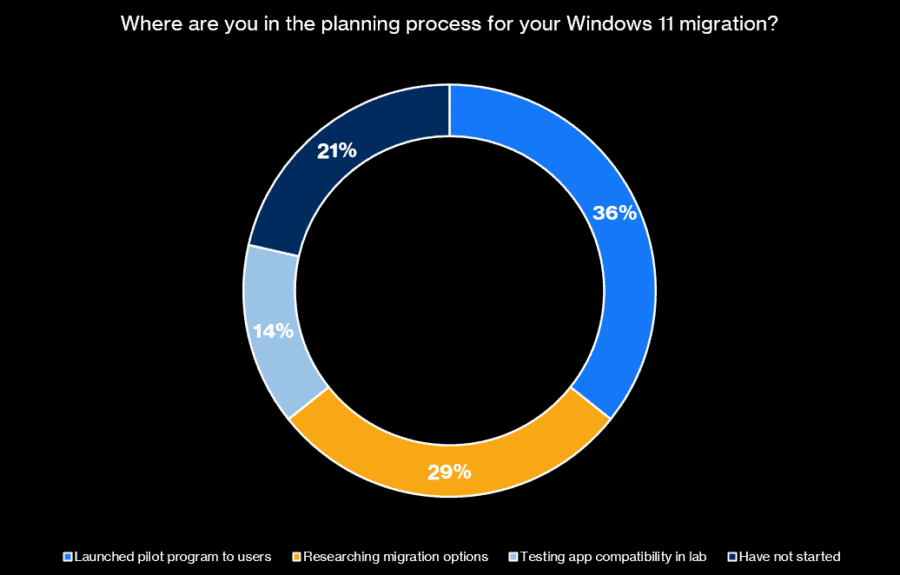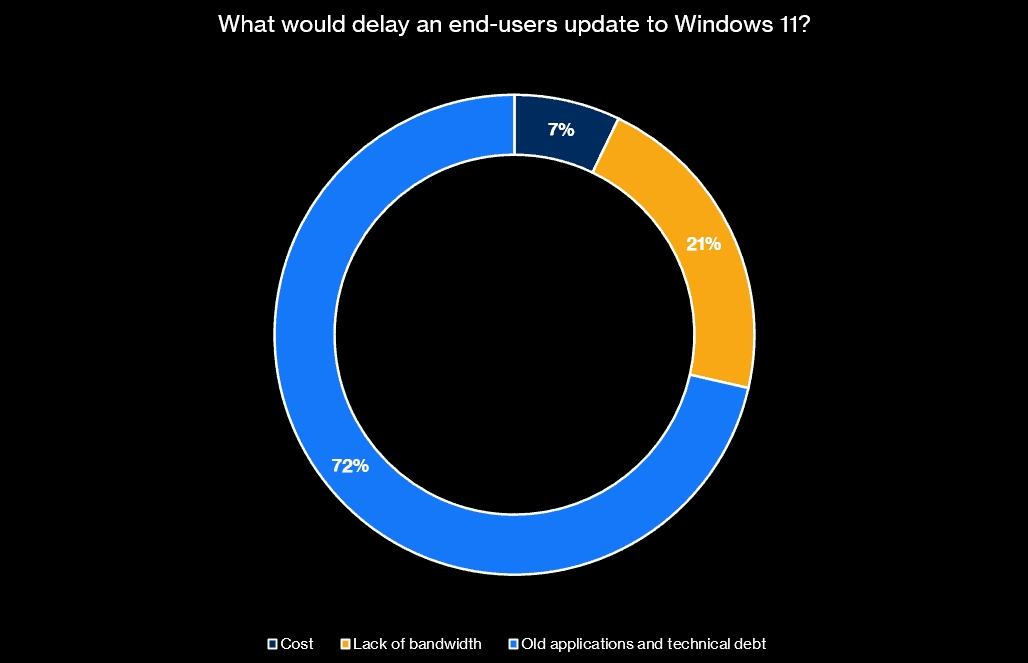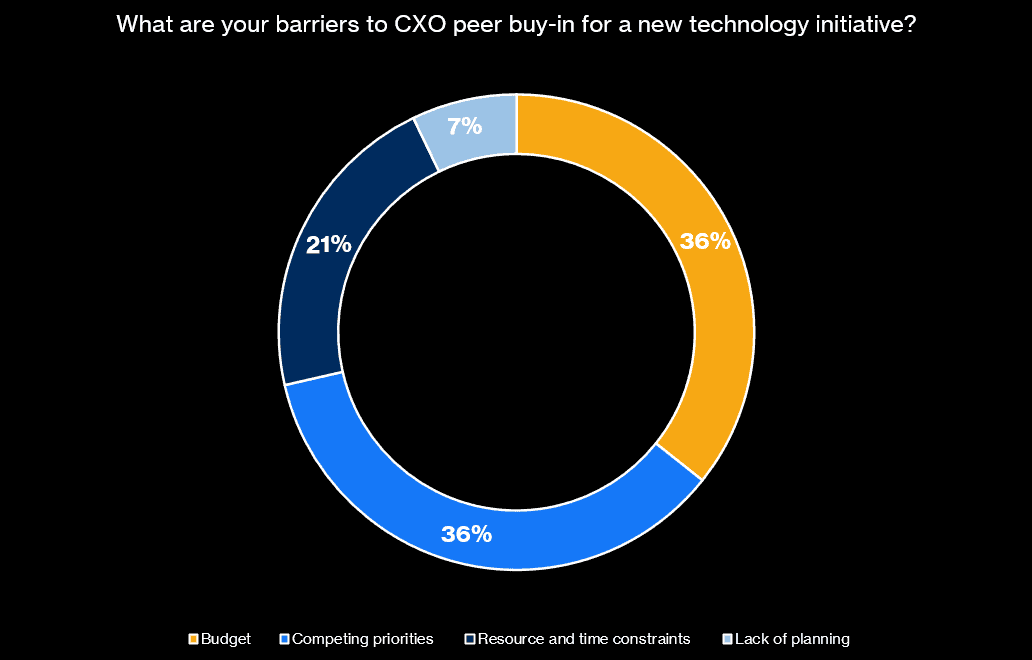CIO Fireside Chat Recap: Microsoft Windows 11 for the Modern Workspace

Today’s CIOs and other IT leaders find themselves at a critical juncture. Windows 10, a rock-solid pillar for many organizations, will reach its end of support on October 14, 2025. The clock is ticking, and the need for migration to Windows 11 is becoming increasingly urgent.
In a recent CIO Fireside Chat webinar, I moderated an interactive discussion between an expert panel and our live audience of IT leaders to understand the current feelings about the impending Windows 11 migration. Mark Rizza, a leading Solution Architect at Blue Mantis with over 35 years of Fortune 100 industry experience as a CIO, CTO, and CISO, brought a cybersecurity perspective to the discussion. With almost 20 years of experience building, maintaining, and fixing Microsoft technology in enterprise environments, Blue Mantis Senior Solutions Architect Jeremy Bello was also on hand to talk about how the Windows 11 rollout differs from prior OS upgrades.
Planning for a Windows 11 rollout and the AI revolution
Having a cybersecurity and Microsoft technology expert on the panel made sense because it wasn’t that long ago when a global health crisis led to an unprecedented purchase of laptops and other hardware to support large-scale remote working. Since Windows 11 and the new Copilot AI are set to fundamentally change how employees work, IT departments are facing new economic realities around what productivity really means.
The fact is that most businesses are long overdue for a hardware refresh. At Blue Mantis, we’re seeing an uptick in IT leaders wanting not just to upgrade some PCs but also take this opportunity to integrate AI tools like Copilot into their business process and give employees a competitive edge. A large strategic endpoint refresh takes planning and resources. Knowing that the October 2025 cutoff date for Windows 10 is likely to sneak up on people, I posed the question “where are IT leaders in their planning process for a Windows 11 migration today?” in a poll to the CIO Fireside Chat’s live audience. The results were interesting to our expert panel:

Jeremy was surprised the majority of respondents had already launched a Windows 11 pilot program to users (36%) so early in the process—almost two years before Microsoft’s end of support date for Windows 10. “I’m happy to see so many IT leaders out in front of this issue,” Jeremy said.
Noting that a respectable 14% were testing legacy Windows 10 apps for compatibility with the upgraded operating system, Mark Rizza pointed out that “testing app compatibility for the legacy and SaaS-like apps are the issue when migrating up to Windows 11.” However, software is not the only concern as Windows 11 also imposes a hardware requirement of a Trusted Platform Module 2.0 which can be a problem for organizations that hold onto laptops and desktops that are a little older.
Why it’s crucial to take inventory of your Windows 10 devices
The discussion around hardware requirements led both Jeremy and Mark to talk about the value of having a viable IT asset inventory and management system. “Coming from a security perspective,” Mark said. “we always advise customers have a good asset management plan including the tools” such as Microsoft Intune. Jeremy chimed in to point out that Microsoft Intune makes it much easier to prepare for a Windows 11 upgrade by letting IT teams “know what [hardware you already have] is going to work and what isn’t.” While IT organizations either without Intune or relying on a third-party asset management tool can still take inventory of their PC fleet prior to a companywide Windows OS upgrade, Jeremy stressed that “it may not always be a simple task” compared to using Microsoft Intune.
One of the attendees in the CIO Fireside Chat audience asked Jeremy and Mark if an option for mitigating potential app compatibility and security issues would be to move employees to a Windows 365 Cloud PC solution. It is a topic that Blue Mantis explored in a blog post late last year, and both Jeremy and Mark believed the idea was a good one—with some caveats. “You’re still going to deal with the application compatibility issues on a Cloud PC that you’d have with a hardware solution,” Jeremy said. From a security standpoint, Mark noted that “it’s harder to exfiltrate the information out of a Cloud PC, especially if you’re using AI tools” but agreed that robust data compliance policies are still required.
Most CIOs are concerned about technical debt and legacy apps
When we polled the live audience on what would delay their move to Windows 11, the majority (72%) responded with “old applications and technical debt” as the top issue:

Blue Mantis is well aware that mitigating technical debt is top of mind for most CIOs. “It’s not surprising,” said Mark, who spent part of his career working primarily with the insurance industry—an industry that Mark said is “notorious for having legacy applications that sometimes are 40 years old.” Rather than a fear of change, the IT leaders in financial-oriented industries are cautious about OS upgrades because those upgrades often break legacy apps that are business critical. Time is money in these industries, and they cannot afford any downtime. Mark stressed that risk of downtime is why IT leaders with legacy apps must “get them into the lab and test them early because you’ll likely need some type of software remediation.”
Tips for CIOs to obtain Windows 11 migration budget from CFOs and their peers
After a discussion about the differences between Microsoft Copilot AI in Windows 11 versus the Copilot AI in Microsoft 365, the final audience poll found that over 70% of the respondents are concerned about obtaining buyoff from their C-suite peers to get the time and money needed for a successful Windows 11 migration:

All panelists agreed that IT leaders can be successful in breaking down these barriers with:
- Ongoing and frequent communication between peers.
- Showing data related to the return on investment.
For the CIO, this means keeping the CFO and peers in the loop when it comes to the business value of a Windows 11 migration. By helping them to understand the employee productivity gains, the value of increased cybersecurity, and explaining the overall ROI early in the process can answer questions related to budgeting and prioritization.
The next Blue Mantis CIO Fireside Chat: Ready for 5G?
I want to thank Mark, Jeremy, and all of the virtual attendees of our CIO Fireside Chat, where we learned that a successful Windows 11 upgrade requires foresight, planning, and a willingness to embrace change. In our next CIO Fireside Chat, we’ll discuss the challenges and opportunities faced by IT leaders when it comes to mainstream adoption of 5G connectivity.
Check back soon on how you can join us at our next CIO Fireside Chat. These events are your opportunity to engage with industry experts, gain insights, and share experiences that can help shape the future of your organization in the era of modern workforces.




